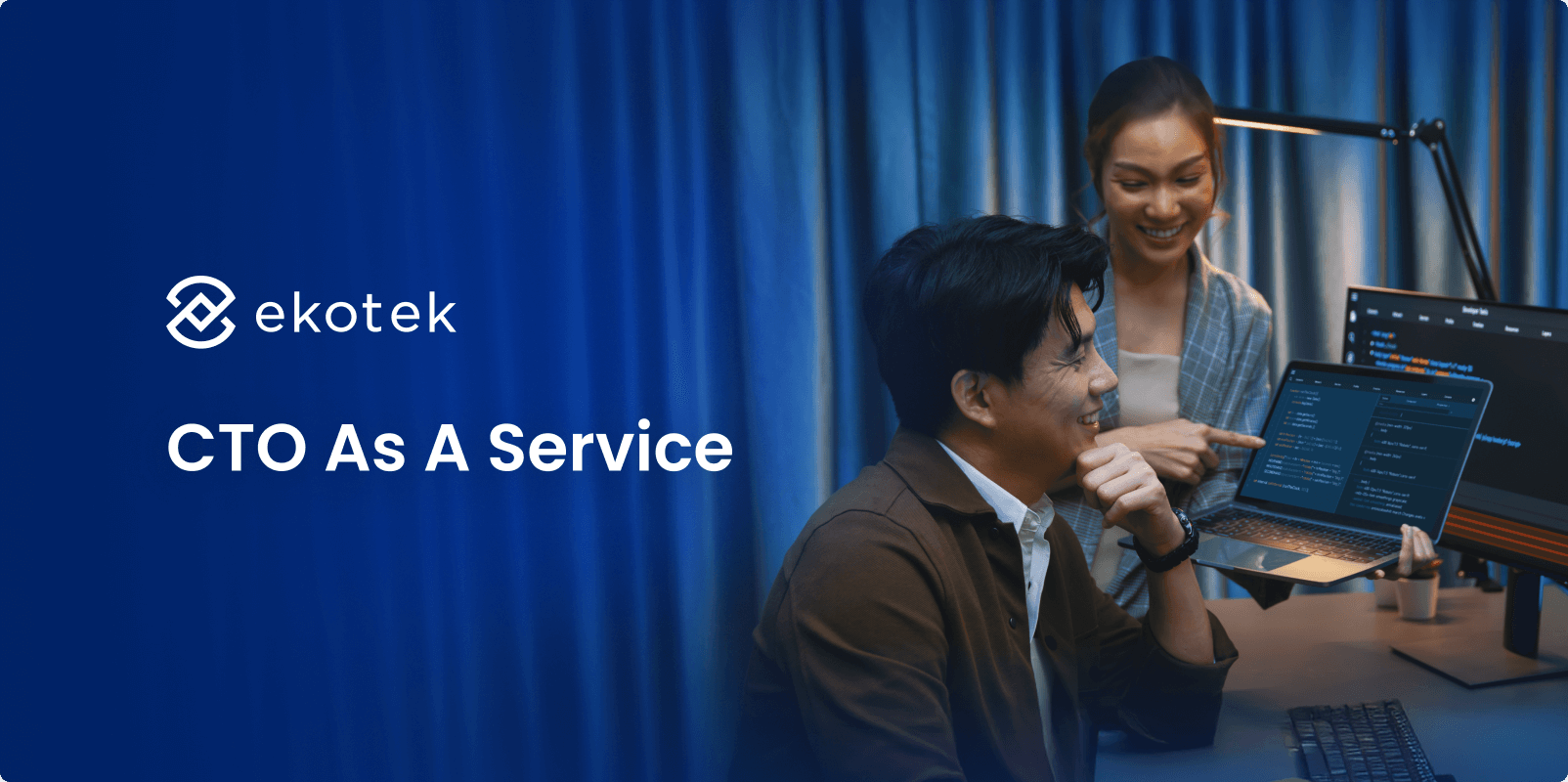
- 1
- 2
- 3
- 4
- 5
- 6
- 7
- 8
- 9
- 10
Introduction
In today’s competitive digital landscape, companies must balance innovation, speed, and scalability without overextending resources. CTO as a Service (CaaS) has emerged as a powerful solution, offering executive-level technology leadership without the cost or commitment of hiring a full-time Chief Technology Officer.
According to a 2024 Deloitte survey, over 47% of mid-sized firms are now turning to fractional or virtual CTO models to accelerate growth while staying lean. This flexible approach gives companies access to strategic tech expertise when they need it most.
In this blog, we’ll explore what CTO as a Service really means, the different models available, the benefits it brings to companies, and how to choose the right provider. We’ll also clear up some common misconceptions along the way.
What is CTO as a Service?
CTO as a Service is a flexible engagement model where a business gains access to a senior technology leader, the equivalent of a Chief Technology Oleader, without hiring one full-time. Instead, the CTO operates on a part-time, interim, or project-based basis, depending on the company’s needs.
CTO as a Service is particularly valuable for companies that:
- Are growing fast but not yet ready to commit to a full-time executive.
- Need strategic tech leadership for a product launch, digital transformation, or scaling.
- Want expert oversight on architecture, team performance, or investor communications, without increasing overhead.
How CTO as a Service differs from an in-house CTO
While both roles share similar responsibilities in terms of guiding technology strategy and execution, their engagement models, cost structure, and flexibility are fundamentally different.
| Aspect | In-house CTO | CTO as a Service |
|---|---|---|
| Engagement | Full-time, long-term executive | Flexible (part-time, interim, etc.) |
| Cost | High fixed cost (salary + equity) | Pay-as-you-go, cost-efficient |
| Hiring time | Months to recruit and onboard | Available quickly, often in days |
| Experience breadth | Usually industry-specific | Multi-sector, startup-to-scale-up |
| Commitment level | Deeply embedded in the company | Strategic partner, not operational |
📌 Need to scale your tech team fast? Discover how staff augmentation and IT outsourcing can help
Common models of CTO as a Service
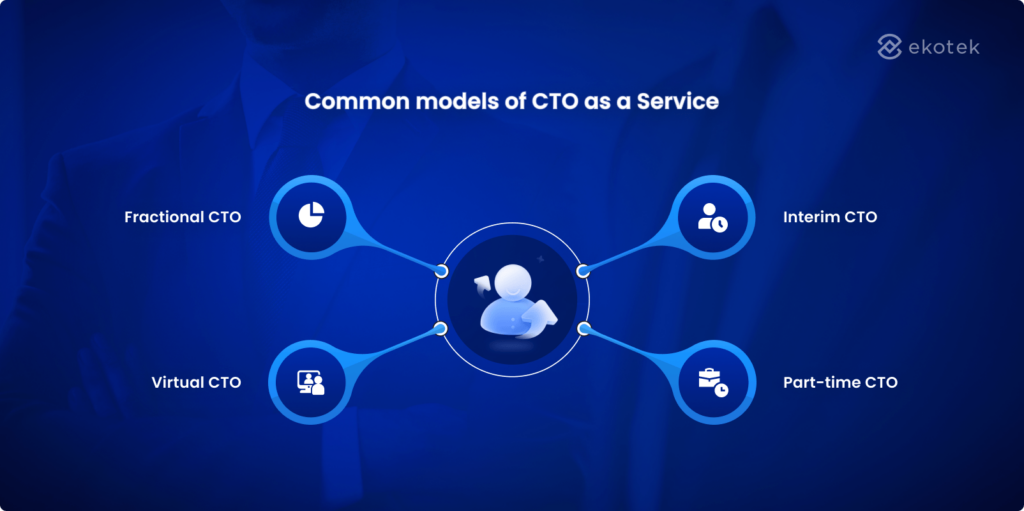
CTO as a Service is not a one-size-fits-all solution. Different outsourcing models are designed to match different company stages, urgency levels, and resource capacities. Below are the four most common types of CaaS, each with distinct engagement styles, characteristics, and cost implications.
Fractional CTO
What it is: A part-time CTO engaged on a recurring schedule, typically a few days or hours per week.
When to use it: For companies needing consistent senior tech guidance without committing to a full-time executive.
Key characteristics:
- Long-term involvement, but with flexible availability.
- Participates in product strategy, hiring, architecture, and scaling decisions.
- Works closely with founders and cross-functional teams.
Cost:
- Moderate: More affordable than a full-time CTO, but with higher rates than one-off consulting.
- Cost-effective for ongoing advisory with predictable scope (1-2 days/week).
Interim CTO
What it is: A temporary CTO stepping in during a leadership gap or transitional phase.
When to use it: During executive turnover, pre-M&A activity, scaling phases, or major restructures.
Key characteristics:
- Takes full ownership of tech strategy and operations during the interim.
- Often involved in recruiting or onboarding the next full-time CTO.
- Ensures continuity and stability.
Cost:
- High: Comparable to full-time CTO compensation on a pro-rated basis.
- Justifiable for short, high-stakes periods where delays or missteps could be costly.
Virtual CTO
What it is: A remote CTO providing strategic oversight and leadership, typically not involved in daily operations.
When to use it: For companies with a distributed or remote team, or those seeking global tech expertise.
Key characteristics:
- Operates fully online, accessible across time zones.
- Advises on architecture, roadmaps, vendor management, and technical hiring.
- May combine advisory and fractional roles.
Cost:
- Flexible to moderate: Lower than on-site roles, and often customized based on engagement depth.
- Can start with light-touch advising, then scale up as needed.
Part-time CTO
What it is: A senior technical leader who contributes on a regular but non-full-time basis, focused more on strategy and mentoring than execution.
When to use it: When an internal dev team needs executive-level direction, or when preparing for investor or board engagements.
Key characteristics:
- Engages in product planning, architecture reviews, and leadership mentoring.
- Supports tech-team development without replacing operational management.
- Often involved in pitch meetings or investor Q&A.
Cost:
- Moderate: Less intensive than fractional or interim CTOs, but more consistent than ad-hoc consulting.
- Suitable for companies with growing complexity but limited executive bandwidth.
📌 Compare onshore, offshore, and nearshore to see what works best for your goals
Benefits of CTO as a Service for companies
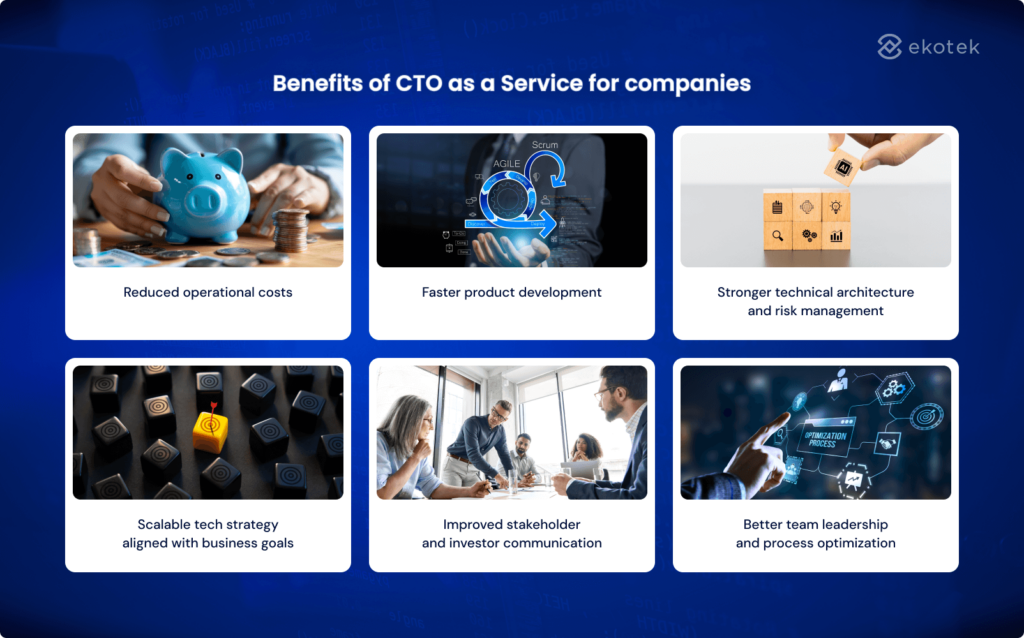
Reduced operational costs
CTO as a Service eliminates the need for a six-figure salary, bonuses, equity packages, and long onboarding cycles. You only pay for the expertise you need, whether that’s a few days per week or a project-based engagement. This makes it an ideal option for budget-conscious companies or those scaling in stages.
📌 Wondering how much custom software really costs? Dive into the key factors that influence pricing
Faster product development
Experienced CTOs help avoid delays, rework, and scope creep. They know how to define the right MVP, prioritize features, and implement agile workflows. The result: your product gets to market faster, with fewer roadblocks and better alignment between tech and business goals.
Stronger technical architecture and risk management
Poor architectural decisions in the early stages can lead to costly rewrites, downtime, or security breaches. A CTO as a Service leader brings deep experience in system design, scalability, and security, reducing long-term technical debt and ensuring your foundation can support future growth.
Scalable tech strategy aligned with business goals
CTO as a Service is not just about execution, it’s about alignment. A capable CTO as a Service will define a tech roadmap that supports your commercial goals, sales strategies, and customer experience. This strategic clarity helps prioritize investments, avoid distractions, and build with purpose.
Improved stakeholder and investor communication
Non-technical stakeholders need clear, concise explanations of complex systems. A CTO as a Service bridges this gap, translating tech direction into business language that resonates with boards, investors, and clients. This is especially valuable during fundraising or strategic planning cycles.
Better team leadership and process optimization
A CTO as a Service provider doesn’t just advise, they lead. They can mentor your development team, define engineering processes, improve code quality standards, and introduce best practices. This builds internal capabilities while ensuring that execution stays efficient and aligned.
Key responsibilities of a CTO as a Service
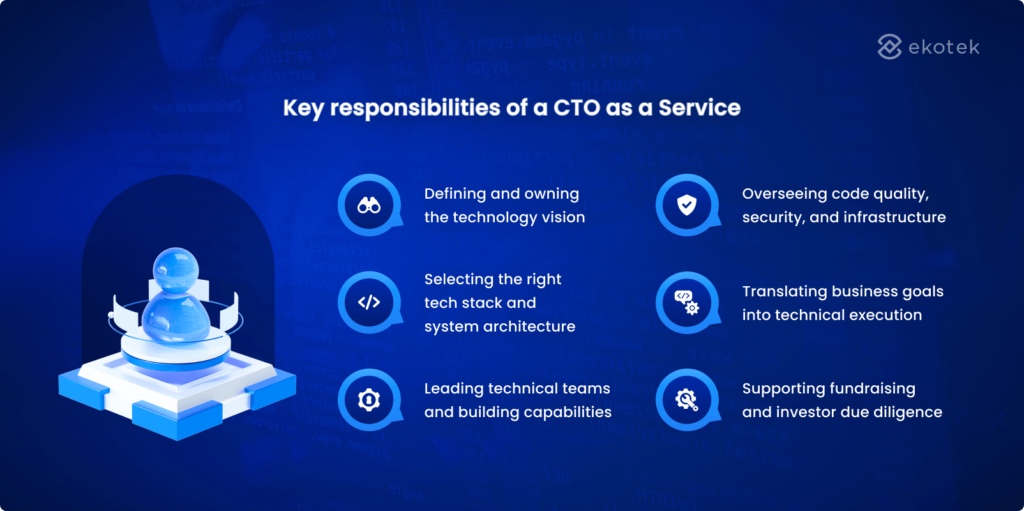
Defining and owning the technology vision
A CTO as a Service helps shape a clear, long-term technology strategy that aligns with your company’s business objectives. This includes building a roadmap that supports current priorities (MVP delivery, integrations) while planning for scale, flexibility, and competitive advantage.
Selecting the right tech stack and system architecture
The CTO is responsible for choosing the tools, platforms, and frameworks that best support product goals. They design an architecture that is scalable, secure, and maintainable, ensuring your product won’t outgrow its foundations too early.
Leading technical teams and building capabilities
A CTO as a Service often steps in as the technical leader of the development team. They set engineering standards, define roles, support hiring, and provide mentorship to team leads and developers, building a high-performing, accountable engineering culture.
Overseeing code quality, security, and infrastructure
They ensure that the product is not just functional but robust. This includes implementing code review processes, defining security protocols, and selecting the right infrastructure for reliability and cost-efficiency.
Translating business goals into technical execution
A key part of the CTO as a Service role is bridging the gap between business vision and technical implementation. They prioritize features, align resources with business value, and ensure product development timelines support broader company objectives.
Supporting fundraising and investor due diligence
When needed, a CTO as a Service can represent the technical side of the business in investor meetings. They prepare technical documentation, product roadmaps, and security/compliance strategies, helping build investor confidence during funding rounds or M&A processes.
A strategic approach to choosing the right CTO as a Service provider
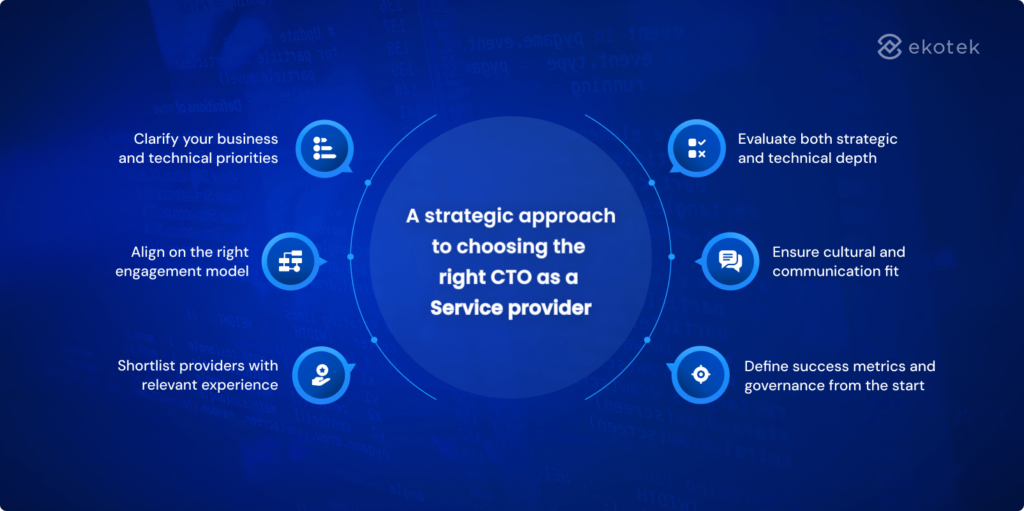
Clarify your business and technical priorities
Every business has unique needs at different stages of growth. Whether you’re building an MVP, modernizing a legacy platform, or preparing for funding, defining clear goals upfront is critical. This includes assessing whether your priority is speed to market, scalability, system reliability, or technical due diligence. These insights will guide not only the type of CTO expertise you require but also the scope and nature of their involvement.
Align on the right engagement model
CTO as a Service comes in different formats, fractional, interim, part-time, or fully virtual. Each model offers different levels of involvement and leadership. For example, a fractional CTO may be ideal for startups needing strategic direction without a full-time hire, while an interim CTO can stabilize operations during leadership transitions. Matching the model to your context ensures cost-efficiency without compromising impact.
Shortlist providers with relevant experience
Not all technical consultants are equipped to act as true CTOs. Look for partners who specialize in CTO as a Service and bring both business acumen and technical leadership. Experience in your industry or business model, such as B2B SaaS, fintech, or e-commerce, adds immediate value and reduces onboarding friction. Proven outcomes, not just technical skills, should guide your selection.
📌 Use this complete guide to evaluate outsourcing vendors and build lasting partnerships
Evaluate both strategic and technical depth
A strong CTO as a Service provider does more than write code. They design architecture, shape product strategy, and make complex decisions in uncertain environments. Reviewing their past engagements, including roadmaps, tech stack choices, and leadership roles, can reveal their ability to connect technology to business value. Cross-industry experience is also a plus, as it often brings a broader perspective.
Ensure cultural and communication fit
A CTO will interface across departments, lead cross-functional discussions, and influence executive-level decisions. Clear communication with both technical and non-technical stakeholders is essential. Just as important is cultural alignment, from leadership style to decision-making tempo. A good fit increases trust, shortens ramp-up time, and leads to smoother collaboration across your organization.
Define success metrics and governance from the start
Effective partnerships thrive on shared expectations. From the outset, agree on how success will be measured, whether it’s the delivery of a product roadmap, technical team expansion, or improved system performance. Establish a working structure that includes communication cadence, reporting formats, and clear boundaries of responsibility. This provides a strong foundation for accountability and long-term success.
Key challenges when adopting CTO as a Service
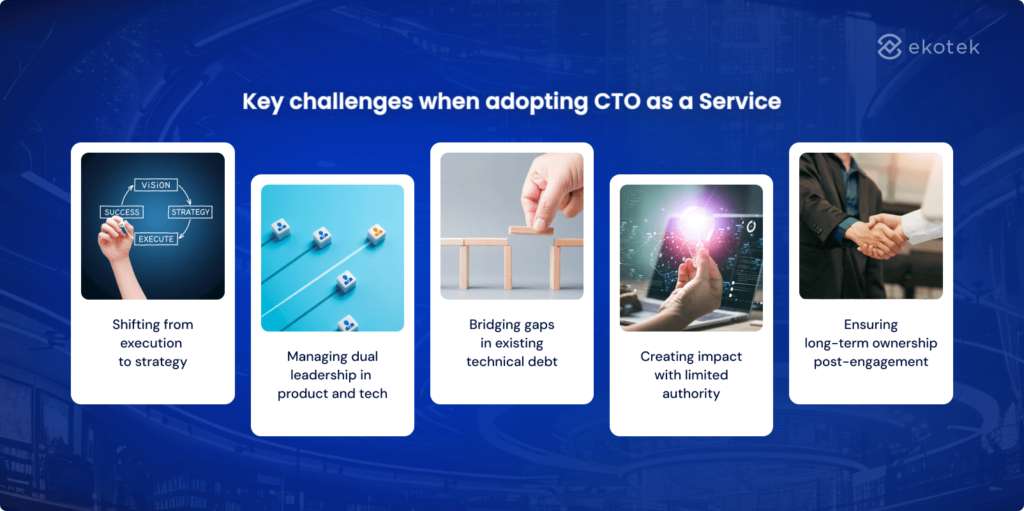
Shifting from execution to strategy
Many companies initially bring in a CTO as a Service expecting quick fixes, faster releases, better architecture, and immediate team output. However, value from a CaaS model comes more from strategic direction than day-to-day execution. Making that mental shift, from “doer” to “strategic partner”, requires alignment from leadership and patience across teams.
Managing dual leadership in product and tech
In many startups and scaleups, the founder or product lead still drives vision, while the CTO (external or internal) is expected to deliver. When these two roles aren’t clearly delineated, conflicts emerge around timelines, prioritization, or technical feasibility. A CTO as a Service provider must navigate this dynamic carefully, but the company also needs to define governance and decision rights clearly.
Bridging gaps in existing technical debt
A common reason to engage a CTO as a Service is to “fix” legacy issues, outdated systems, poor documentation, or inconsistent dev practices. But without proper context, these environments can slow progress. One of the hardest challenges is deciding what to preserve, what to refactor, and what to rebuild, all while minimizing disruption to live operations.
📌 Discover how our IT staffing support helped transform a VR video product
Creating impact with limited authority
Unlike in-house executives, a CTO as a Service provider doesn’t always have hiring power, budget control, or org-chart influence. This can limit their ability to drive change unless executive sponsors actively empower them. Without visible backing from the CEO or board, initiatives may stall, regardless of technical merit.
Ensuring long-term ownership post-engagement
CTO as a Service is often a temporary engagement. But if handoff planning isn’t done early, teams may struggle to maintain momentum once the provider exits. Building internal champions, documenting decisions, and creating a transition roadmap are often overlooked, but are critical steps for sustainable outcomes.
Ekotek CTO as a Service for growing companies
Our CTO as a Service is designed for B2B companies that are scaling fast and need strategic technology leadership without the overhead of a full-time CTO.
- Technology strategy and planning: We help define a long-term technology roadmap that aligns with your business goals, selecting the right tech stack to support scalability and performance.
- Architecture and scalable system design: Our team designs and implements secure, efficient architectures to support product stability, growth, and long-term maintainability.
- Product development guidance: From setting up engineering workflows to defining delivery processes, we ensure your development team follows best practices from day one.
- Digital transformation enablement: Whether you’re modernizing legacy systems or moving to cloud-native infrastructure, we help you adopt scalable solutions that drive business acceleration.
- Team and vendor management: We assist with team structure, hiring strategies, and managing third-party relationships, ensuring the right mix of talent and partners.
- Fundraising and investor support: Need to prepare for a funding round? We support pitch readiness with technical insights, due diligence materials, and investor Q&A preparation.
Conclusion
In a fast-moving digital world, technology leadership can no longer be reactive or optional. CTO as a Service offers a smart, flexible path for B2B companies to gain strategic direction, technical oversight, and team leadership, without the long-term costs or delays of a traditional CTO hire.
To truly unlock the value of CTO as a Service, choosing the right partner is crucial. With Ekotek, you’re not just getting advisors, you’re gaining seasoned tech leaders who’ve built and scaled real products, led fundraising rounds, and understand the demands of fast-growth companies.
From our proven track record of 400+ global projects to our powerhouse of 200+ engineers, we execute with speed, clarity, and quality from day one. Our delivery emphasizes architecture excellence, testing, and security, eliminating technical debt by design. With structured collaboration and transparent communication, we integrate like your true CTO, not a distant vendor.
Whether you’re launching a new product, scaling your tech team, or need interim tech leadership, Ekotek’s CTO as a Service is built to help your business lead with confidence and deliver with impact.
- 1
- 2
- 3
- 4
- 5
- 6
- 7
- 8
- 9
- 10